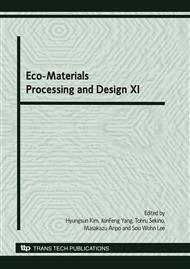p.236
p.240
p.244
p.248
p.252
p.256
p.260
p.264
p.268
Effects of Oxygen Plasma Treated Carbon Nanotube Coating Basalt Filaments
Abstract:
The strain rate sensitivity of Oxygen plasma treated carbon nanotube sol-gel coating Basalt and concurrent microstructural evolution investigated. Both the materials are strain rate sensitive and the change in index parameter of strain rate sensitivity with strain reflects the change in micromechanisms of deformation and mode of fracture. From the SEM micrographs, an increase in surface roughness can observed and the degree of fibrillation decreased after helium and oxygen plasma treatment. Contact angle analysis showed the treated Basalt filament had lower contact angles than the untreated one. Based on FTIR results, the change of wettability and surface energy is attributable to polar groups on the fiber surface introduced by the treatments. Deformation processes in the Oxygen plasma treated carbon nano tube sol-gel coating Basalt involved craze-tearing and brittle mode of fracture, while plasma treated carbon nano tube in nano-composites filaments predominantly characterized by wedge, ridge tearing, fibrillation and brittle fracture. Depend yield stress of the Oxygen plasma treated carbon nanotube sol-gel coating Basalt with strain rate follows Eyring’s equation.
Info:
Periodical:
Pages:
252-255
Citation:
Online since:
July 2010
Authors:
Price:
Сopyright:
© 2010 Trans Tech Publications Ltd. All Rights Reserved
Share:
Citation:


